Yixuan Gao
Audio-Assisted Face Video Restoration with Temporal and Identity Complementary Learning
Aug 06, 2025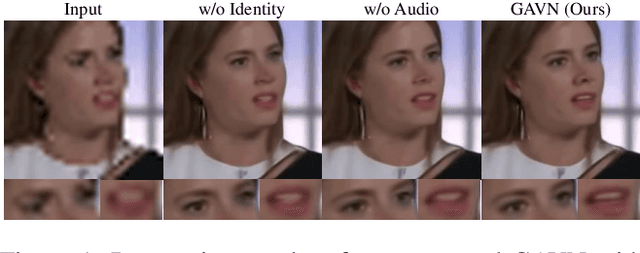
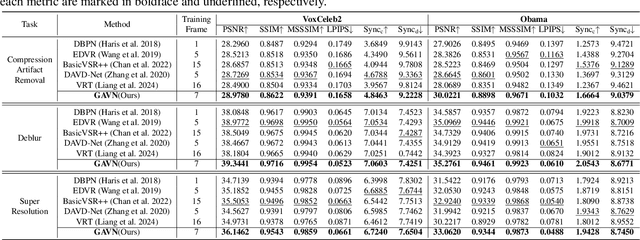
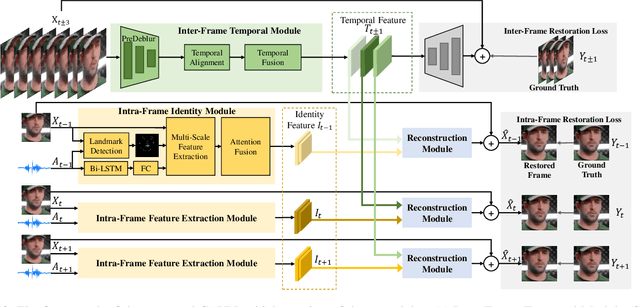
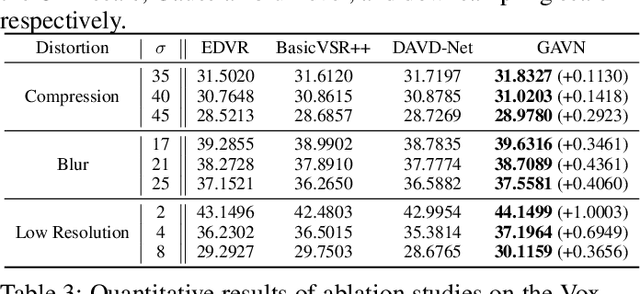
Abstract:Face videos accompanied by audio have become integral to our daily lives, while they often suffer from complex degradations. Most face video restoration methods neglect the intrinsic correlations between the visual and audio features, especially in mouth regions. A few audio-aided face video restoration methods have been proposed, but they only focus on compression artifact removal. In this paper, we propose a General Audio-assisted face Video restoration Network (GAVN) to address various types of streaming video distortions via identity and temporal complementary learning. Specifically, GAVN first captures inter-frame temporal features in the low-resolution space to restore frames coarsely and save computational cost. Then, GAVN extracts intra-frame identity features in the high-resolution space with the assistance of audio signals and face landmarks to restore more facial details. Finally, the reconstruction module integrates temporal features and identity features to generate high-quality face videos. Experimental results demonstrate that GAVN outperforms the existing state-of-the-art methods on face video compression artifact removal, deblurring, and super-resolution. Codes will be released upon publication.
Exploring Image Quality Assessment from a New Perspective: Pupil Size
May 20, 2025Abstract:This paper explores how the image quality assessment (IQA) task affects the cognitive processes of people from the perspective of pupil size and studies the relationship between pupil size and image quality. Specifically, we first invited subjects to participate in a subjective experiment, which includes two tasks: free observation and IQA. In the free observation task, subjects did not need to perform any action, and they only needed to observe images as they usually do with an album. In the IQA task, subjects were required to score images according to their overall impression of image quality. Then, by analyzing the difference in pupil size between the two tasks, we find that people may activate the visual attention mechanism when evaluating image quality. Meanwhile, we also find that the change in pupil size is closely related to image quality in the IQA task. For future research on IQA, this research can not only provide a theoretical basis for the objective IQA method and promote the development of more effective objective IQA methods, but also provide a new subjective IQA method for collecting the authentic subjective impression of image quality.
FVQ: A Large-Scale Dataset and A LMM-based Method for Face Video Quality Assessment
Apr 12, 2025



Abstract:Face video quality assessment (FVQA) deserves to be explored in addition to general video quality assessment (VQA), as face videos are the primary content on social media platforms and human visual system (HVS) is particularly sensitive to human faces. However, FVQA is rarely explored due to the lack of large-scale FVQA datasets. To fill this gap, we present the first large-scale in-the-wild FVQA dataset, FVQ-20K, which contains 20,000 in-the-wild face videos together with corresponding mean opinion score (MOS) annotations. Along with the FVQ-20K dataset, we further propose a specialized FVQA method named FVQ-Rater to achieve human-like rating and scoring for face video, which is the first attempt to explore the potential of large multimodal models (LMMs) for the FVQA task. Concretely, we elaborately extract multi-dimensional features including spatial features, temporal features, and face-specific features (i.e., portrait features and face embeddings) to provide comprehensive visual information, and take advantage of the LoRA-based instruction tuning technique to achieve quality-specific fine-tuning, which shows superior performance on both FVQ-20K and CFVQA datasets. Extensive experiments and comprehensive analysis demonstrate the significant potential of the FVQ-20K dataset and FVQ-Rater method in promoting the development of FVQA.
Mitigating Low-Level Visual Hallucinations Requires Self-Awareness: Database, Model and Training Strategy
Mar 27, 2025



Abstract:The rapid development of multimodal large language models has resulted in remarkable advancements in visual perception and understanding, consolidating several tasks into a single visual question-answering framework. However, these models are prone to hallucinations, which limit their reliability as artificial intelligence systems. While this issue is extensively researched in natural language processing and image captioning, there remains a lack of investigation of hallucinations in Low-level Visual Perception and Understanding (HLPU), especially in the context of image quality assessment tasks. We consider that these hallucinations arise from an absence of clear self-awareness within the models. To address this issue, we first introduce the HLPU instruction database, the first instruction database specifically focused on hallucinations in low-level vision tasks. This database contains approximately 200K question-answer pairs and comprises four subsets, each covering different types of instructions. Subsequently, we propose the Self-Awareness Failure Elimination (SAFEQA) model, which utilizes image features, salient region features and quality features to improve the perception and comprehension abilities of the model in low-level vision tasks. Furthermore, we propose the Enhancing Self-Awareness Preference Optimization (ESA-PO) framework to increase the model's awareness of knowledge boundaries, thereby mitigating the incidence of hallucination. Finally, we conduct comprehensive experiments on low-level vision tasks, with the results demonstrating that our proposed method significantly enhances self-awareness of the model in these tasks and reduces hallucinations. Notably, our proposed method improves both accuracy and self-awareness of the proposed model and outperforms close-source models in terms of various evaluation metrics.
AGAV-Rater: Adapting Large Multimodal Model for AI-Generated Audio-Visual Quality Assessment
Jan 30, 2025



Abstract:Many video-to-audio (VTA) methods have been proposed for dubbing silent AI-generated videos. An efficient quality assessment method for AI-generated audio-visual content (AGAV) is crucial for ensuring audio-visual quality. Existing audio-visual quality assessment methods struggle with unique distortions in AGAVs, such as unrealistic and inconsistent elements. To address this, we introduce AGAVQA, the first large-scale AGAV quality assessment dataset, comprising 3,382 AGAVs from 16 VTA methods. AGAVQA includes two subsets: AGAVQA-MOS, which provides multi-dimensional scores for audio quality, content consistency, and overall quality, and AGAVQA-Pair, designed for optimal AGAV pair selection. We further propose AGAV-Rater, a LMM-based model that can score AGAVs, as well as audio and music generated from text, across multiple dimensions, and selects the best AGAV generated by VTA methods to present to the user. AGAV-Rater achieves state-of-the-art performance on AGAVQA, Text-to-Audio, and Text-to-Music datasets. Subjective tests also confirm that AGAV-Rater enhances VTA performance and user experience. The project page is available at https://agav-rater.github.io.
Exploring Rich Subjective Quality Information for Image Quality Assessment in the Wild
Sep 09, 2024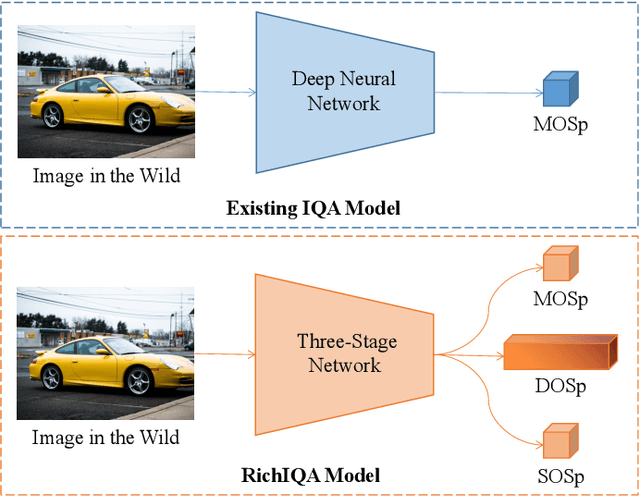


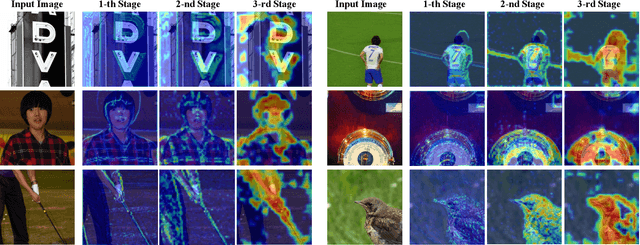
Abstract:Traditional in the wild image quality assessment (IQA) models are generally trained with the quality labels of mean opinion score (MOS), while missing the rich subjective quality information contained in the quality ratings, for example, the standard deviation of opinion scores (SOS) or even distribution of opinion scores (DOS). In this paper, we propose a novel IQA method named RichIQA to explore the rich subjective rating information beyond MOS to predict image quality in the wild. RichIQA is characterized by two key novel designs: (1) a three-stage image quality prediction network which exploits the powerful feature representation capability of the Convolutional vision Transformer (CvT) and mimics the short-term and long-term memory mechanisms of human brain; (2) a multi-label training strategy in which rich subjective quality information like MOS, SOS and DOS are concurrently used to train the quality prediction network. Powered by these two novel designs, RichIQA is able to predict the image quality in terms of a distribution, from which the mean image quality can be subsequently obtained. Extensive experimental results verify that the three-stage network is tailored to predict rich quality information, while the multi-label training strategy can fully exploit the potentials within subjective quality rating and enhance the prediction performance and generalizability of the network. RichIQA outperforms state-of-the-art competitors on multiple large-scale in the wild IQA databases with rich subjective rating labels. The code of RichIQA will be made publicly available on GitHub.
UNQA: Unified No-Reference Quality Assessment for Audio, Image, Video, and Audio-Visual Content
Jul 29, 2024



Abstract:As multimedia data flourishes on the Internet, quality assessment (QA) of multimedia data becomes paramount for digital media applications. Since multimedia data includes multiple modalities including audio, image, video, and audio-visual (A/V) content, researchers have developed a range of QA methods to evaluate the quality of different modality data. While they exclusively focus on addressing the single modality QA issues, a unified QA model that can handle diverse media across multiple modalities is still missing, whereas the latter can better resemble human perception behaviour and also have a wider range of applications. In this paper, we propose the Unified No-reference Quality Assessment model (UNQA) for audio, image, video, and A/V content, which tries to train a single QA model across different media modalities. To tackle the issue of inconsistent quality scales among different QA databases, we develop a multi-modality strategy to jointly train UNQA on multiple QA databases. Based on the input modality, UNQA selectively extracts the spatial features, motion features, and audio features, and calculates a final quality score via the four corresponding modality regression modules. Compared with existing QA methods, UNQA has two advantages: 1) the multi-modality training strategy makes the QA model learn more general and robust quality-aware feature representation as evidenced by the superior performance of UNQA compared to state-of-the-art QA methods. 2) UNQA reduces the number of models required to assess multimedia data across different modalities. and is friendly to deploy to practical applications.
Light-VQA+: A Video Quality Assessment Model for Exposure Correction with Vision-Language Guidance
May 06, 2024



Abstract:Recently, User-Generated Content (UGC) videos have gained popularity in our daily lives. However, UGC videos often suffer from poor exposure due to the limitations of photographic equipment and techniques. Therefore, Video Exposure Correction (VEC) algorithms have been proposed, Low-Light Video Enhancement (LLVE) and Over-Exposed Video Recovery (OEVR) included. Equally important to the VEC is the Video Quality Assessment (VQA). Unfortunately, almost all existing VQA models are built generally, measuring the quality of a video from a comprehensive perspective. As a result, Light-VQA, trained on LLVE-QA, is proposed for assessing LLVE. We extend the work of Light-VQA by expanding the LLVE-QA dataset into Video Exposure Correction Quality Assessment (VEC-QA) dataset with over-exposed videos and their corresponding corrected versions. In addition, we propose Light-VQA+, a VQA model specialized in assessing VEC. Light-VQA+ differs from Light-VQA mainly from the usage of the CLIP model and the vision-language guidance during the feature extraction, followed by a new module referring to the Human Visual System (HVS) for more accurate assessment. Extensive experimental results show that our model achieves the best performance against the current State-Of-The-Art (SOTA) VQA models on the VEC-QA dataset and other public datasets.
NTIRE 2024 Quality Assessment of AI-Generated Content Challenge
Apr 25, 2024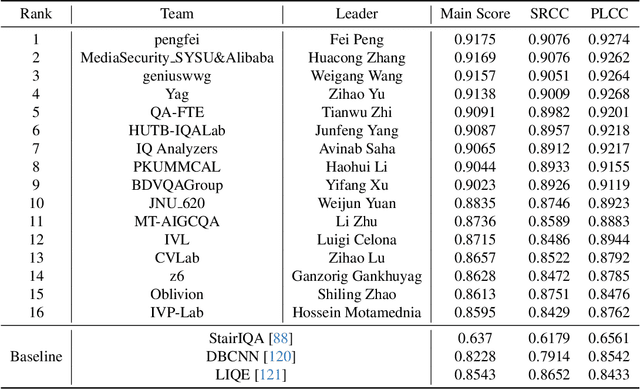
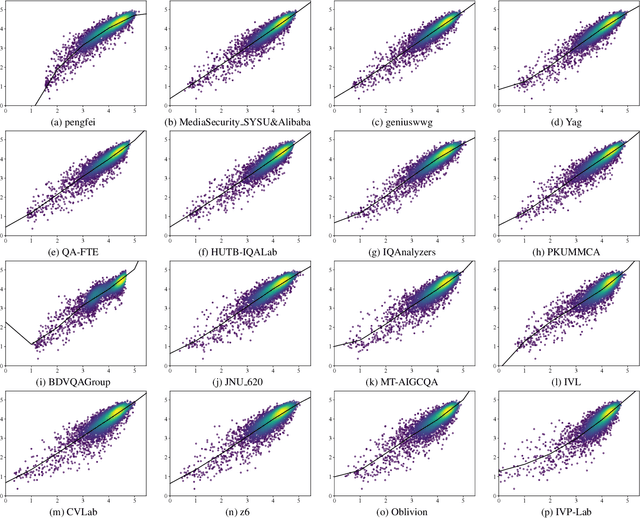
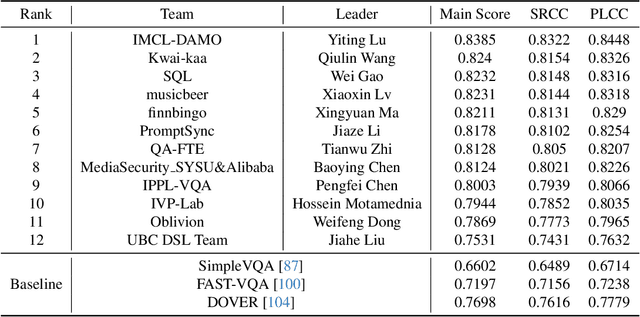
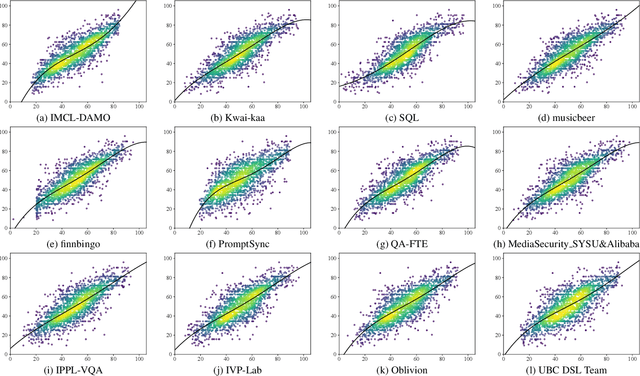
Abstract:This paper reports on the NTIRE 2024 Quality Assessment of AI-Generated Content Challenge, which will be held in conjunction with the New Trends in Image Restoration and Enhancement Workshop (NTIRE) at CVPR 2024. This challenge is to address a major challenge in the field of image and video processing, namely, Image Quality Assessment (IQA) and Video Quality Assessment (VQA) for AI-Generated Content (AIGC). The challenge is divided into the image track and the video track. The image track uses the AIGIQA-20K, which contains 20,000 AI-Generated Images (AIGIs) generated by 15 popular generative models. The image track has a total of 318 registered participants. A total of 1,646 submissions are received in the development phase, and 221 submissions are received in the test phase. Finally, 16 participating teams submitted their models and fact sheets. The video track uses the T2VQA-DB, which contains 10,000 AI-Generated Videos (AIGVs) generated by 9 popular Text-to-Video (T2V) models. A total of 196 participants have registered in the video track. A total of 991 submissions are received in the development phase, and 185 submissions are received in the test phase. Finally, 12 participating teams submitted their models and fact sheets. Some methods have achieved better results than baseline methods, and the winning methods in both tracks have demonstrated superior prediction performance on AIGC.
AIGIQA-20K: A Large Database for AI-Generated Image Quality Assessment
Apr 04, 2024



Abstract:With the rapid advancements in AI-Generated Content (AIGC), AI-Generated Images (AIGIs) have been widely applied in entertainment, education, and social media. However, due to the significant variance in quality among different AIGIs, there is an urgent need for models that consistently match human subjective ratings. To address this issue, we organized a challenge towards AIGC quality assessment on NTIRE 2024 that extensively considers 15 popular generative models, utilizing dynamic hyper-parameters (including classifier-free guidance, iteration epochs, and output image resolution), and gather subjective scores that consider perceptual quality and text-to-image alignment altogether comprehensively involving 21 subjects. This approach culminates in the creation of the largest fine-grained AIGI subjective quality database to date with 20,000 AIGIs and 420,000 subjective ratings, known as AIGIQA-20K. Furthermore, we conduct benchmark experiments on this database to assess the correspondence between 16 mainstream AIGI quality models and human perception. We anticipate that this large-scale quality database will inspire robust quality indicators for AIGIs and propel the evolution of AIGC for vision. The database is released on https://www.modelscope.cn/datasets/lcysyzxdxc/AIGCQA-30K-Image.
 Add to Chrome
Add to Chrome Add to Firefox
Add to Firefox Add to Edge
Add to Edge